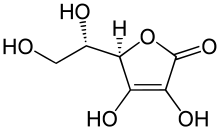
Back Vitamien C Afrikaans فيتامين سي Arabic فيتامين سى ARZ Vitamina C AST C vitamini Azerbaijani ویتامین ث AZB Vitamin C BAN Bitamina C BCL Аскарбінавая кіслата Byelorussian Вітамін C BE-X-OLD
 | |
 | |
| Clinical data | |
|---|---|
| Pronunciation | /əˈskɔːrbɪk/, /əˈskɔːrbeɪt, -bɪt/ |
| Trade names | Ascor, Cecon, Cevalin, others |
| Other names | l-ascorbic acid, ascorbic acid, ascorbate |
| AHFS/Drugs.com | Monograph |
| MedlinePlus | a682583 |
| License data | |
| Routes of administration | By mouth, intramuscular (IM), intravenous (IV), subcutaneous |
| ATC code | |
| Legal status | |
| Legal status | |
| Pharmacokinetic data | |
| Bioavailability | Rapid, diminishes as dose increases[4] |
| Protein binding | Negligible |
| Elimination half-life | Varies according to plasma concentration |
| Excretion | Kidney |
| Identifiers | |
| |
| CAS Number | |
| PubChem CID | |
| IUPHAR/BPS | |
| DrugBank | |
| ChemSpider | |
| UNII |
|
| KEGG | |
| ChEBI |
|
| ChEMBL |
|
| NIAID ChemDB | |
| PDB ligand | |
| E number | E300 (antioxidants, ...) |
| CompTox Dashboard (EPA) | |
| ECHA InfoCard | 100.000.061 |
| Chemical and physical data | |
| Formula | C6H8O6 |
| Molar mass | 176.124 g·mol−1 |
| 3D model (JSmol) | |
| Density | 1.694 g/cm3 |
| Melting point | 190 to 192 °C (374 to 378 °F) |
| Boiling point | 552.7 °C (1,026.9 °F) [5] |
| |
| |
| (verify) | |
Vitamin C (also known as ascorbic acid and ascorbate) is a water-soluble vitamin found in citrus and other fruits, berries and vegetables. It is also a generic prescription medication and in some countries is sold as a non-prescription dietary supplement. As a therapy, it is used to prevent and treat scurvy, a disease caused by vitamin C deficiency.
Vitamin C is an essential nutrient involved in the repair of tissue, the formation of collagen, and the enzymatic production of certain neurotransmitters. It is required for the functioning of several enzymes and is important for immune system function.[6] It also functions as an antioxidant. Vitamin C may be taken by mouth or by intramuscular, subcutaneous or intravenous injection. Various health claims exist on the basis that moderate vitamin C deficiency increases disease risk, such as for the common cold, cancer or COVID-19.[clarification needed] There are also claims of benefits from vitamin C supplementation in excess of the recommended dietary intake for people who are not considered vitamin C deficient.[clarification needed] Vitamin C is generally well-tolerated. Large doses may cause gastrointestinal discomfort, headache, trouble sleeping, and flushing of the skin. The United States Institute of Medicine recommends against consuming large amounts.[7]: 155–165
Most animals are able to synthesize their own vitamin C. However, apes (including humans) and monkeys (but not all primates), most bats, most fish, some rodents, and certain other animals must acquire it from dietary sources because a gene for a synthesis enzyme has mutations that render it dysfunctional.
Vitamin C was discovered in 1912, isolated in 1928, and in 1933, was the first vitamin to be chemically produced. Partly for its discovery, Albert Szent-Györgyi was awarded the 1937 Nobel Prize in Physiology or Medicine.
- ^ "Ascorbic acid injection 500mg/5ml". (emc). July 15, 2015. Archived from the original on October 14, 2020. Retrieved October 12, 2020.
- ^ "Ascorbic acid 100mg tablets". (emc). October 29, 2018. Archived from the original on September 21, 2020. Retrieved October 12, 2020.
- ^ "Ascor- ascorbic acid injection". DailyMed. October 2, 2020. Archived from the original on October 29, 2020. Retrieved October 12, 2020.
- ^ Cite error: The named reference
NIH2021was invoked but never defined (see the help page). - ^ "Vitamin C". Chem Spider. Royal Society of Chemistry. Archived from the original on July 24, 2020. Retrieved July 25, 2020.
- ^ "Vitamin C". Micronutrient Information Center, Linus Pauling Institute, Oregon State University, Corvallis, OR. July 1, 2018. Archived from the original on July 12, 2019. Retrieved June 19, 2019.
- ^ Institute of Medicine (US) Panel on Dietary Antioxidants Related Compounds (2000). "Vitamin C". Dietary Reference Intakes for Vitamin C, Vitamin E, Selenium, and Carotenoids. Washington, DC: The National Academies Press. pp. 95–185. doi:10.17226/9810. ISBN 978-0-309-06935-9. PMID 25077263. Archived from the original on September 2, 2017. Retrieved September 1, 2017.
© MMXXIII Rich X Search. We shall prevail. All rights reserved. Rich X Search